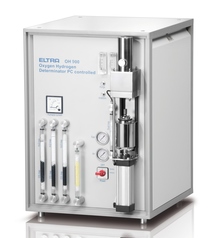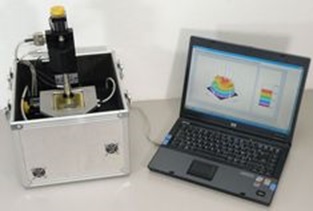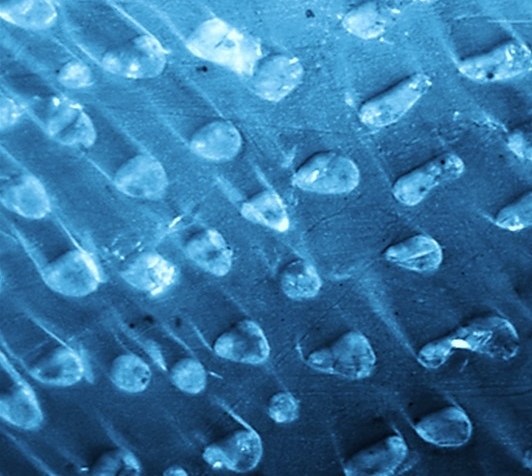CapeSym
Tools for Materials Characterization
Software
Characterization
In-depth characterization of materials produced at CapeSym is used to uncover factors which influence the performance of our materials and identify pathways for improving purification and crystal growth processes. We have assembled an extensive portfolio of commercially-available characterization tools, and have a strong in-house effort for development of unique and specialized tools.
Click below for more information about our available tools. Please Contact Us for characterization of your samples.
Unique Instruments & Techniques
Oxygen Analysis with the ELTRA ON-900 Our Eltra ON-900 oxygen analyzer is used to measure the oxygen content of inorganic samples down to 1 ppm. In this technique, the sample is melted in an outgassed graphite crucible. Oxygen present in the sample reacts with the graphite to produce carbon monoxide, which is swept by a carrier gas to a copper oxide catalyst. Here the CO gas is converted into CO2, and an IR cell is used to measure the CO2 concentration in the gas stream. The oxygen content of the starting sample is calculated by the equipment software. Analysis time is typically on the order of several minutes per sample. Our Eltra system is loaded in a moisture-monitored glovebox for moisture sensitive samples.
Our Eltra ON-900 oxygen analyzer is used to measure the oxygen content of inorganic samples down to 1 ppm. In this technique, the sample is melted in an outgassed graphite crucible. Oxygen present in the sample reacts with the graphite to produce carbon monoxide, which is swept by a carrier gas to a copper oxide catalyst. Here the CO gas is converted into CO2, and an IR cell is used to measure the CO2 concentration in the gas stream. The oxygen content of the starting sample is calculated by the equipment software. Analysis time is typically on the order of several minutes per sample. Our Eltra system is loaded in a moisture-monitored glovebox for moisture sensitive samples. CapeSym has built a micro-luminescence system which can automatically generate a 2D map of the emission wavelength and light intensity of scintillators, with a spatial resolution of as low as 200 microns. This information can be used to measure the spatial uniformity of the scintillator, and in conjunction with other capabilities of the system correlate scintillation variations to features and defects in the sample. A Hg lamp provides UV excitation while the emission is directed to a Horiba MicroHR spectrometer. The current filter set-ups are suitable for Eu-doped scintillators with emission in the visible range. In reflection mode, these filters are replaced by a 3% neutral density filter. Custom software controls a motorized XYZ stage that automatically rasters across a 4 inches square area for image mapping. Other software-automated capabilities include: 2D image mapping for transmission, reflection, birefringence, peak emission centroid and magnitude; 2D precipitate/inclusion/defect and secondary phase measurements, 3D imaging in transmission, and 3D mapping and statistics of secondary phase distribution.
CapeSym has built a micro-luminescence system which can automatically generate a 2D map of the emission wavelength and light intensity of scintillators, with a spatial resolution of as low as 200 microns. This information can be used to measure the spatial uniformity of the scintillator, and in conjunction with other capabilities of the system correlate scintillation variations to features and defects in the sample. A Hg lamp provides UV excitation while the emission is directed to a Horiba MicroHR spectrometer. The current filter set-ups are suitable for Eu-doped scintillators with emission in the visible range. In reflection mode, these filters are replaced by a 3% neutral density filter. Custom software controls a motorized XYZ stage that automatically rasters across a 4 inches square area for image mapping. Other software-automated capabilities include: 2D image mapping for transmission, reflection, birefringence, peak emission centroid and magnitude; 2D precipitate/inclusion/defect and secondary phase measurements, 3D imaging in transmission, and 3D mapping and statistics of secondary phase distribution. Our current pulse-height spectroscopy set-up allows the measurement of standard scintillation properties such as relative light yield, energy resolution, and decay time. Our suite of solid gamma ray sources allows measurement of light yield proportionality. Our PMT is located inside a glovebox for measurement of hygroscopic scintillators.
Our current pulse-height spectroscopy set-up allows the measurement of standard scintillation properties such as relative light yield, energy resolution, and decay time. Our suite of solid gamma ray sources allows measurement of light yield proportionality. Our PMT is located inside a glovebox for measurement of hygroscopic scintillators. Accelerated Device Degradation (ADD) is used to quantify the effect of crystal growth and fabrication improvements on the lifetime of TlBr devices. ADD provides direct observation (using transmission microscopy) of defect formation and propagation in TlBr devices under controllable bias of up to 2000V over a temperature range of -40 degC to 80 degC. Lifetime tests at various temperatures and biases provides for identification of the activation energy of lifetime-controlling events, as well as the ability to predict room temperature lifetime quickly. The figure shows a degrading TlBr detector after 450 hours under 1000 V/cm bias at 50 degC temperature. The fern-like features on the left and the dark region to the right are defects formed during ADD.
Accelerated Device Degradation (ADD) is used to quantify the effect of crystal growth and fabrication improvements on the lifetime of TlBr devices. ADD provides direct observation (using transmission microscopy) of defect formation and propagation in TlBr devices under controllable bias of up to 2000V over a temperature range of -40 degC to 80 degC. Lifetime tests at various temperatures and biases provides for identification of the activation energy of lifetime-controlling events, as well as the ability to predict room temperature lifetime quickly. The figure shows a degrading TlBr detector after 450 hours under 1000 V/cm bias at 50 degC temperature. The fern-like features on the left and the dark region to the right are defects formed during ADD.

